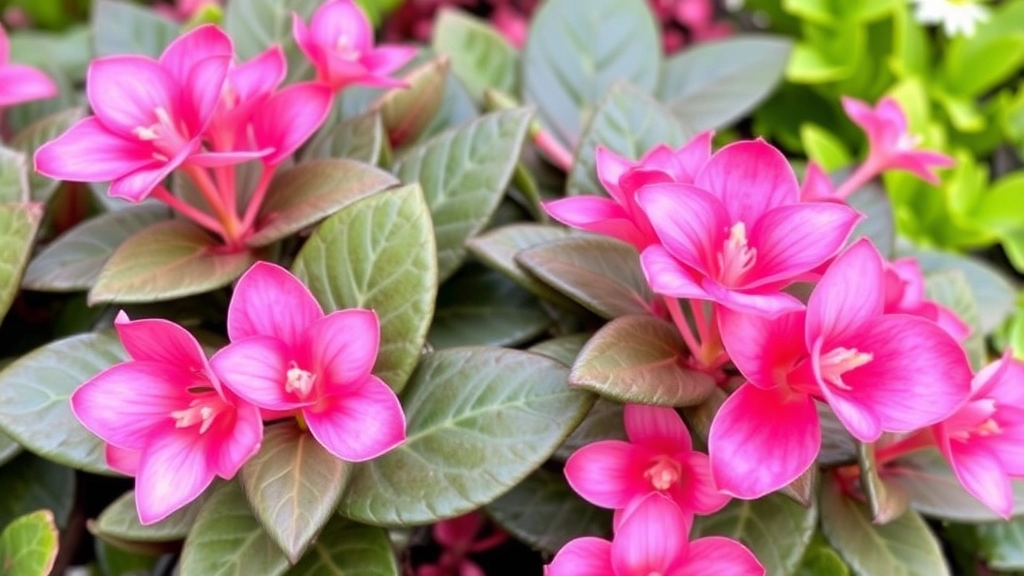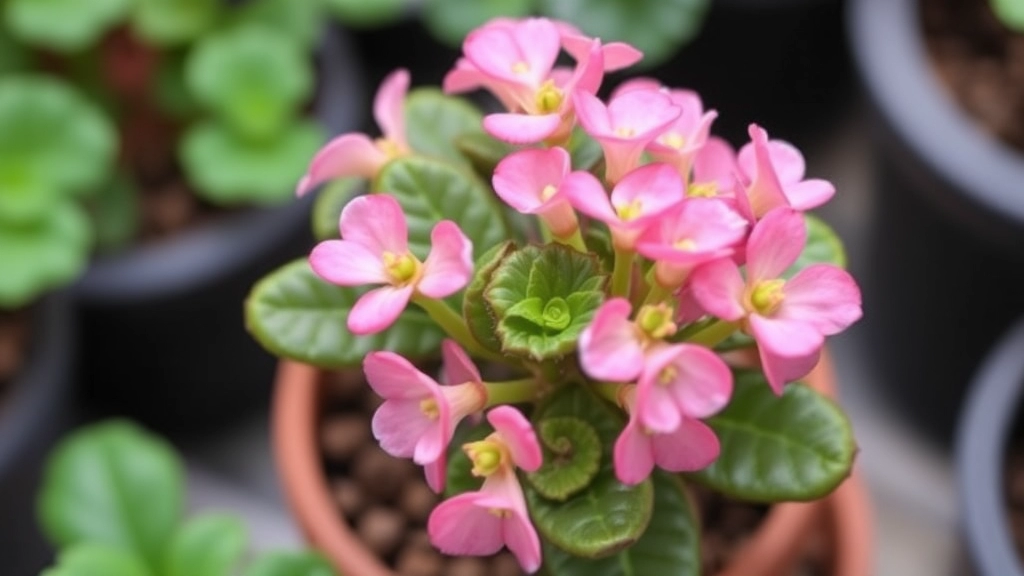Kalanchoe Pink Butterflies
If you’re as captivated by Kalanchoe pink leaves as I am, you’re in the right place. The “Kalanchoe Pink Butterflies” variety is particularly stunning, with its vibrant pink hues adding a splash of colour to any space. Let’s dive into what makes this plant so special and how you can keep it thriving.
Key Features
Understanding the key features of Kalanchoe ‘Pink Butterflies’ is the first step. This unique plant stands out with its pink-tinted leaves, which are not only beautiful but also relatively easy to care for. Ideal growing conditions include:
- Bright, indirect sunlight
- Well-draining soil
Proper watering techniques and knowing how to propagate these beauties will ensure your Kalanchoe remains healthy and vibrant.
Key Features of Kalanchoe ‘Pink Butterflies’
When considering the addition of a unique plant to your collection, Kalanchoe ‘Pink Butterflies’ often comes to mind.
This stunning succulent is celebrated for its distinct characteristics that make it a favourite among gardeners and plant enthusiasts alike.
Ideal Growing Conditions for Pink-Leaved Kalanchoes

So, you’ve got your heart set on Kalanchoe ‘Pink Butterflies’, but are you sure you know the best way to help it thrive?
These stunning plants love a bit of TLC when it comes to their environment.
Light Requirements
- Bright, Indirect Light: They adore bright light but can’t handle harsh, direct sun for too long.
- Partial Shade: If you’re in a super sunny spot, a little shade during the hottest part of the day can work wonders.
Temperature Preferences
- Ideal Range: Aim for temperatures between 18-24°C (65-75°F).
- Avoid Cold Drafts: Keep them away from chilly windows or doors; they’re not fans of sudden temperature drops.
Humidity Levels
- Low to Moderate Humidity: These beauties prefer drier air, so don’t stress about keeping the humidity high.
- Good Air Circulation: A well-ventilated spot can help prevent any unwanted issues.
Soil Type
- Well-Draining Soil: Use a cactus or succulent mix. This helps prevent root rot, which is a common worry for many plant parents.
- pH Level: They thrive in slightly acidic to neutral soil (around pH 6-7).
Potting Considerations
- Terracotta Pots: These are a great choice as they allow for extra airflow and help with drainage.
- Repotting: Consider repotting every couple of years to refresh the soil and give those roots some space to grow.
Effective Watering and Drainage Techniques for Kalanchoe ‘Pink Butterflies’
When it comes to caring for your Kalanchoe ‘Pink Butterflies’, effective watering and drainage techniques are crucial for its health. Many plant enthusiasts worry about overwatering or underwatering, which can lead to root rot or dehydration.
Understanding Water Needs
Kalanchoes are succulents, meaning they store water in their leaves. Here’s how to ensure your plant thrives:
- Soil Check: Always use well-draining soil. A cactus or succulent mix works wonders.
- Watering Frequency: Water your Kalanchoe every 2-3 weeks. Adjust based on the season; they require less water in winter.
- Moisture Test: Stick your finger about an inch into the soil. If it feels dry, it’s time to water.
Drainage Essentials
Proper drainage is non-negotiable for Kalanchoe ‘Pink Butterflies’. Without it, excess water can lead to root issues. Here are some tips:
- Pot Choice: Use pots with drainage holes. This allows excess water to escape.
- Layering: Consider adding a layer of gravel or small stones at the bottom of the pot for extra drainage.
- Avoid Saucers: If you use a saucer, ensure it’s emptied after watering to prevent standing water.
Signs of Watering Issues
Being vigilant about your plant’s health can save you from bigger problems later. Watch for these signs:
- Overwatering: Yellowing leaves or mushy stems indicate too much water.
- Underwatering: Wrinkled or shrivelling leaves signal a need for more moisture.
For more detailed information on growing and caring for Kalanchoe ‘Pink Butterflies’, check out our complete guide. Additionally, if you’re interested in other varieties, our Kalanchoe succulent identification guide offers insights into top varieties and their traits.
Propagation Methods for Kalanchoe ‘Pink Butterflies’

When it comes to expanding your collection of Kalanchoe ‘Pink Butterflies’, understanding effective propagation methods is essential. This vibrant succulent can be easily propagated, allowing you to share its beauty with friends or enhance your own garden.
Leaf Cuttings
One of the most straightforward methods is through leaf cuttings. Here’s how to do it:
- Select a Healthy Leaf: Choose a plump, healthy leaf from the parent plant.
- Cut the Leaf: Use a clean, sharp knife to slice the leaf at the base.
- Let it Callous: Place the cutting in a dry area for a few days until the cut edge has dried and formed a callous.
- Plant the Cutting: Insert the calloused end into well-draining soil, ensuring it’s stable.
- Water Sparingly: Mist the soil lightly to encourage root development, but avoid overwatering.
Stem Cuttings
Another effective method is stem cuttings, which can yield quick results.
- Choose a Stem: Identify a healthy stem with a few leaves.
- Cut the Stem: Cut just below a leaf node.
- Callous the Cutting: Allow the cut end to dry for a couple of days.
- Plant in Soil: Place the cutting in well-draining soil, burying it about an inch deep.
- Water Lightly: Water the soil lightly and place the pot in a bright, indirect light.
Offsets
Kalanchoe ‘Pink Butterflies’ can also produce offsets, or “pups,” which can be separated and planted.
- Identify Offsets: Look for small plants growing around the base of the parent plant.
- Remove Offsets: Gently twist or cut them away from the parent.
- Plant Separately: Place them in their own pots with well-draining soil.
- Water Lightly: Water them sparingly until they establish roots.
Care After Propagation
After propagating, it’s crucial to provide the right care to ensure successful growth.
- Light: Keep the new plants in bright, indirect sunlight.
- Humidity: Maintain moderate humidity levels to encourage growth.
- Soil: Use a cactus or succulent mix to facilitate drainage.
As we delve into the care of Kalanchoe ‘Pink Butterflies’, it’s essential to address a common concern among plant enthusiasts: pests and diseases.
### Identifying Common Pests
Kalanchoe plants, while generally resilient, can fall prey to a few pesky invaders. Here are the most common:
– **Mealybugs**: These small, white, cotton-like pests can often be found hiding in the leaf axils or under leaves.
– **Aphids**: Tiny and green, aphids can cluster on new growth, sucking sap and weakening the plant.
– **Spider Mites**: These minuscule pests thrive in dry conditions, leaving fine webbing and yellow spots on leaves.
### Preventive Measures
To keep your Kalanchoe ‘Pink Butterflies’ healthy, consider the following preventive strategies:
– **Regular Inspections**: Check your plants weekly for any signs of pests. Early detection is key.
– **Proper Air Circulation**: Ensure your plants have enough space to breathe. This reduces humidity and makes it less inviting for pests.
– **Clean Leaves**: Wipe leaves with a damp cloth to remove dust and deter pests.
### Disease Prevention
Kalanchoe plants are also susceptible to certain diseases, primarily due to overwatering or poor drainage. Here’s how to keep them thriving:
– **Root Rot**: This is a common issue caused by excessive moisture. Ensure your pot has drainage holes and use well-draining soil.
– **Powdery Mildew**: This fungal disease appears as a white powdery substance on leaves. Avoid overhead watering and ensure good air circulation.
### Treatment Options
If you do encounter pests or diseases, here are some effective treatments:
– **Neem Oil**: A natural pesticide that can help combat pests without harming your plant.
– **Insecticidal Soap**: Effective against soft-bodied insects like aphids and mealybugs.
– **Fungicides**: For fungal diseases, applying a suitable fungicide can help control outbreaks.
By incorporating these strategies, you can protect your Kalanchoe ‘Pink Butterflies’ and ensure it remains a stunning addition to your collection. For more detailed care tips, check out our [complete guide to caring for Kalanchoe ‘Pink Butterflies’](https://planthq.org/care-tips-for-kalanchoe-pink-butterflies-succulent/). Additionally, if you’re interested in learning about other varieties and their care, visit our [top Kalanchoe succulent varieties and care tips](https://planthq.org/top-kalanchoe-succulent-varieties-and-care-tips/).
FAQs about Kalanchoe Pink Leaves
What are the ideal light conditions for Kalanchoe ‘Pink Butterflies’?
Kalanchoe ‘Pink Butterflies’ thrive in bright, indirect light. They can also tolerate partial shade, especially during the hottest part of the day to prevent sunburn.
What temperature range is best for Kalanchoe ‘Pink Butterflies’?
The ideal temperature range for these plants is between 18-24°C (65-75°F). It’s important to keep them away from cold drafts and sudden temperature drops.
Do Kalanchoe ‘Pink Butterflies’ need high humidity?
No, they prefer low to moderate humidity. Good air circulation is also beneficial to prevent any potential issues.
What type of soil is best for Kalanchoe ‘Pink Butterflies’?
These plants do well in well-draining soil, such as a cactus or succulent mix. The soil pH should be slightly acidic to neutral (around pH 6-7).
What kind of pots are suitable for Kalanchoe ‘Pink Butterflies’?
Terracotta pots are a great choice because they allow for extra airflow and help with drainage. Repotting every couple of years is also recommended to refresh the soil and give the roots more space.
How can I propagate Kalanchoe ‘Pink Butterflies’?
You can propagate Kalanchoe ‘Pink Butterflies’ through leaf cuttings, stem cuttings, or offsets. Each method involves selecting healthy parts of the plant, allowing them to callous, and then planting them in well-draining soil.
What care is needed after propagating Kalanchoe ‘Pink Butterflies’?
After propagation, place the new plants in bright, indirect sunlight, maintain moderate humidity, and use a cactus or succulent mix for the soil to ensure proper drainage.
How often should I water Kalanchoe ‘Pink Butterflies’ after propagation?
Water the new plants sparingly. Mist the soil lightly to encourage root development, but avoid overwatering to prevent root rot.
Can I share Kalanchoe ‘Pink Butterflies’ with friends?
Yes, Kalanchoe ‘Pink Butterflies’ can be easily propagated, making it simple to share its beauty with friends or enhance your own garden.
References
-
How to Grow and Care for Kalanchoe ‘Pink Butterflies’
-
Kalanchoe Pink Butterflies: Growing and Care Guide
-
Kalanchoe Pink Butterflies Care Guide
